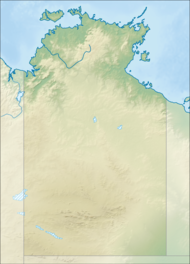Channel Point Coastal Reserve
Protected area in the Northern Territory, Australia From Wikipedia, the free encyclopedia
Channel Point Coastal Reserve is a protected area in the Northern Territory of Australia.
| Channel Point Coastal Reserve Northern Territory | |
|---|---|
IUCN category V (protected landscape/seascape)[1] | |
| Nearest town or city | Darwin |
| Coordinates | 13°09′51″S 130°07′00″E |
| Established | 2005[2] |
| Area | 2.50 km2 (1.0 sq mi)[3] |
| Managing authorities | Parks and Wildlife Commission of the Northern Territory |
| Website | Channel Point Coastal Reserve |
| See also | Protected areas of the Northern Territory |
It is situated approximately 240 kilometres (149 mi) south west of Darwin opposite the Peron Islands and between the mouth of the Daly River and Channel Point. The reserve overlaps with the Anson Bay, Daly and Reynolds River Floodplains, an Important Bird and Biodiversity Area.
Facilities in the area include a boat ramp, camping area and a small internal road to the boat ramp. The infrastructure development was commenced in 2006 and completed shortly afterward.[4] It is adjacent to the Aboriginal community of Bulgul and the private residential area known as Channel Point Community.
The area contains habitat for many species of birds including royal spoonbills, magpie geese, plumed whistling-duck, grey teal and glossy ibis.[5]
Climate
| Climate data for Channel Point, elevation 3 m (9.8 ft), (1994–2020 normals, extremes 1994–present) | |||||||||||||
|---|---|---|---|---|---|---|---|---|---|---|---|---|---|
| Month | Jan | Feb | Mar | Apr | May | Jun | Jul | Aug | Sep | Oct | Nov | Dec | Year |
| Record high °C (°F) | 35.0 (95.0) |
35.0 (95.0) |
35.0 (95.0) |
35.5 (95.9) |
35.2 (95.4) |
34.1 (93.4) |
34.7 (94.5) |
36.0 (96.8) |
38.0 (100.4) |
37.7 (99.9) |
38.5 (101.3) |
35.7 (96.3) |
38.5 (101.3) |
| Mean daily maximum °C (°F) | 31.7 (89.1) |
31.6 (88.9) |
32.0 (89.6) |
32.5 (90.5) |
31.2 (88.2) |
29.3 (84.7) |
29.3 (84.7) |
29.6 (85.3) |
31.1 (88.0) |
32.3 (90.1) |
32.9 (91.2) |
32.3 (90.1) |
31.3 (88.4) |
| Mean daily minimum °C (°F) | 25.1 (77.2) |
25.2 (77.4) |
24.8 (76.6) |
23.5 (74.3) |
20.7 (69.3) |
17.7 (63.9) |
17.1 (62.8) |
18.2 (64.8) |
21.6 (70.9) |
24.1 (75.4) |
25.0 (77.0) |
25.1 (77.2) |
22.3 (72.2) |
| Record low °C (°F) | 18.0 (64.4) |
20.3 (68.5) |
18.4 (65.1) |
15.5 (59.9) |
13.5 (56.3) |
9.9 (49.8) |
10.0 (50.0) |
10.9 (51.6) |
14.0 (57.2) |
17.7 (63.9) |
19.8 (67.6) |
20.6 (69.1) |
9.9 (49.8) |
| Average rainfall mm (inches) | 457.6 (18.02) |
385.5 (15.18) |
331.5 (13.05) |
104.2 (4.10) |
13.4 (0.53) |
0.8 (0.03) |
0.1 (0.00) |
3.6 (0.14) |
11.3 (0.44) |
71.0 (2.80) |
125.8 (4.95) |
314.3 (12.37) |
1,819.1 (71.61) |
| Average rainy days (≥ 1.0 mm) | 18.2 | 16.6 | 15.2 | 6.5 | 1.2 | 0.1 | 0.0 | 0.3 | 1.3 | 4.8 | 8.6 | 14.9 | 87.7 |
| Source: Australian Bureau of Meteorology[6] | |||||||||||||
See also
References
Wikiwand - on
Seamless Wikipedia browsing. On steroids.
